- Home
- George R. R. Martin
Nightflyers: The Illustrated Edition
Nightflyers: The Illustrated Edition Read online
Nightflyers is a work of fiction. Names, places, and incidents either are products of the author’s imagination or are used fictitiously. Any resemblance to actual events, locales, or persons, living or dead, is entirely coincidental.
Copyright © 1980, 1981 by George R. R. Martin
Text illustrations copyright © 2018 by David Palumbo
All rights reserved.
Published in the United States by Bantam Books, an imprint of Random House, a division of Penguin Random House LLC, New York.
BANTAM BOOKS and the HOUSE colophon are registered trademarks of Penguin Random House LLC.
From Binary Star 5 (Dell, 1981). A shorter version of this story originally appeared in Analog, April 1980, copyright © 1980 by the Condé Nast Publications, Inc. Published as part of Dreamsongs: Volume I (Bantam, 2007).
LIBRARY OF CONGRESS CATALOGING-IN-PUBLICATION DATA
Names: Martin, George R. R., author.
Title: Nightflyers / George R. R. Martin.
Description: Illustrated edition. | New York : Bantam, 2018.
Identifiers: LCCN 2018005083 | ISBN 9780525619680 (hardcover) | ISBN 9780525619697 (ebook)
Subjects: LCSH: Space ships—Fiction. | Murder—Fiction. | BISAC: FICTION / Horror. | GSAFD: Science fiction. | Horror fiction.
Classification: LCC PS3563.A7239 N54 2018 | DDC 813/.54—dc23 LC record available at https://lccn.loc.gov/2018005083
Ebook ISBN 9780525619697
randomhousebooks.com
Book design by Virginia Norey, adapted for ebook
Cover design: David G. Stevenson
Cover illustration: Larry Rostant
v5.2
ep
Contents
Cover
Title Page
Copyright
Nightflyers
Dedication
By George R. R. Martin
About the Author
About the Illustrator
WHEN JESUS OF NAZARETH HUNG DYING on his cross, the volcryn passed within a year of his agony, headed outward.
When the Fire Wars raged on Earth, the volcryn sailed near Old Poseidon, where the seas were still unnamed and unfished. By the time the stardrive had transformed the Federated Nations of Earth into the Federal Empire, the volcryn had moved into the fringes of Hrangan space. The Hrangans never knew it. Like us they were children of the small bright worlds that circled their scattered suns, with little interest and less knowledge of the things that moved in the gulfs between.
War flamed for a thousand years and the volcryn passed through it, unknowing and untouched, safe in a place where no fires could ever burn. Afterwards, the Federal Empire was shattered and gone, and the Hrangans vanished in the dark of the Collapse, but it was no darker for the volcryn.
When Kleronomas took his survey ship out from Avalon, the volcryn came within ten light-years of him. Kleronomas found many things, but he did not find the volcryn. Not then and not on his return to Avalon, a lifetime later.
When I was a child of three, Kleronomas was dust, as distant and dead as Jesus of Nazareth, and the volcryn passed close to Daronne. That season all the Crey sensitives grew strange and sat staring at the stars with luminous, flickering eyes.
When I was grown, the volcryn had sailed beyond Tara, past the range of even the Crey, still heading outward.
And now I am old and growing older and the volcryn will soon pierce the Tempter’s Veil where it hangs like a black mist between the stars. And we follow, we follow. Through the dark gulfs where no one goes, through the emptiness, through the silence that goes on and on, my Nightflyer and I give chase.
* * *
—
They made their way slowly down the length of the transparent tube that linked the orbital docks to the waiting starship ahead, pulling themselves hand over hand through weightlessness.
Melantha Jhirl, the only one among them who did not seem clumsy and ill at ease in free fall, paused briefly to look at the dappled globe of Avalon below, a stately vastness in jade and amber. She smiled and moved swiftly down the tube, passing her companions with an easy grace. They had boarded starships before, all of them, but never like this. Most ships docked flush against the station, but the craft that Karoly d’Branin had chartered for his mission was too large, and too singular in design. It loomed ahead; three small eggs side by side, two larger spheres beneath and at right angles, the cylinder of the driveroom between, lengths of tube connecting it all. The ship was white and austere.
Melantha Jhirl was the first one through the airlock. The others straggled up one by one until they had all boarded; five women and four men, each an Academy scholar, their backgrounds as diverse as their fields of study. The frail young telepath, Thale Lasamer, was the last to enter. He glanced about nervously as the others chatted and waited for the entry procedure to be completed. “We’re being watched,” he said.
The outer door was closed behind them, the tube had fallen away; now the inner door slid open. “Welcome to my Nightflyer,” said a mellow voice from within.
But there was no one there.
Melantha Jhirl stepped into the corridor. “Hello,” she said, looking about quizzically. Karoly d’Branin followed her.
“Hello,” the mellow voice replied. It was coming from a communicator grille beneath a darkened viewscreen. “This is Royd Eris, master of the Nightflyer. I’m pleased to see you again, Karoly, and pleased to welcome the rest of you.”
“Where are you?” someone demanded.
“In my quarters, which occupy half of this life-support sphere,” the voice of Royd Eris replied amiably. “The other half is comprised of a lounge-library-kitchen, two sanitary stations, one double cabin, and a rather small single. The rest of you will have to rig sleepwebs in the cargo spheres, I’m afraid. The Nightflyer was designed as a trader, not a passenger vessel. However, I’ve opened all the appropriate passageways and locks, so the holds have air and heat and water. I thought you’d find it more comfortable that way. Your equipment and computer system have been stowed in the holds, but there is still plenty of space, I assure you. I suggest you settle in, and then meet in the lounge for a meal.”
“Will you join us?” asked the psipsych, a querulous hatchet-faced woman named Agatha Marij-Black.
“In a fashion,” Royd Eris said, “in a fashion.”
* * *
—
The ghost appeared at the banquet.
They found the lounge easily enough, after they had rigged their sleepwebs and arranged their personal belongings around their sleeping quarters. It was the largest room in this section of the ship. One end of it was a fully equipped kitchen, well stocked with provisions. The opposite end offered several comfortable chairs, two readers, a holotank, and a wall of books and tapes and crystal chips. In the center was a long table with places set for ten.
A light meal was hot and waiting. The academicians helped themselves and took seats at the table, laughing and talking to one another, more at ease now than when they had boarded.
The ship’s gravity grid was on, which went a long way towards making them more comfortable; the queasy awkwardness of their weightless transit was soon forgotten.
Finally all the seats were occupied except for one at the head of the table.
The ghost materialized there.
All conversation stopped.
“Hello,” said the spectre, the bright shade of a lithe, pale-eyed young man with white hair. He was dressed in clot
hing twenty years out-of-date; a loose blue pastel shirt that ballooned at his wrists, clinging white trousers with built-in boots. They could see through him, and his own eyes did not see them at all.
“A hologram,” said Alys Northwind, the short, stout xenotech.
“Royd, Royd, I do not understand,” said Karoly d’Branin, staring at the ghost. “What is this? Why do you send us a projection? Will you not join us in person?”
The ghost smiled faintly and lifted an arm. “My quarters are on the other side of that wall,” he said. “I’m afraid there is no door or lock between the two halves of the sphere. I spend most of my time by myself, and I value my privacy. I hope you will all understand and respect my wishes. I will be a gracious host nonetheless. Here in the lounge my projection can join you. Elsewhere, if you have anything you need, if you want to talk to me, just use a communicator. Now, please resume your meal, and your conversations. I’ll gladly listen. It’s been a long time since I had passengers.”
They tried. But the ghost at the head of the table cast a long shadow, and the meal was strained and hurried.
* * *
—
From the hour the Nightflyer slipped into stardrive, Royd Eris watched his passengers.
Within a few days most of the academicians had grown accustomed to the disembodied voice from the communicators and the holographic spectre in the lounge, but only Melantha Jhirl and Karoly d’Branin ever seemed really comfortable in his presence. The others would have been even more uncomfortable if they had known that Royd was always with them. Always and everywhere, he watched. Even in the sanitary stations, Royd had eyes and ears.
He watched them work, eat, sleep, copulate; he listened untiringly to their talk. Within a week he knew them, all nine, and had begun to ferret out their tawdry little secrets.
The cyberneticist, Lommie Thorne, talked to her computers and seemed to prefer their company to that of humans. She was bright and quick, with a mobile, expressive face and a small, hard boyish body; most of the others found her attractive, but she did not like to be touched. She sexed only once, with Melantha Jhirl. Lommie Thorne wore shirts of softly woven metal, and had an implant in her left wrist that let her interface directly with her computers.
The xenobiologist, Rojan Christopheris, was a surly, argumentative man, a cynic whose contempt for his colleagues was barely kept in check, a solitary drinker. He was tall and stooped and ugly.
The two linguists, Dannel and Lindran, were lovers in public, constantly holding hands and supporting each other. In private they quarreled bitterly. Lindran had a mordant wit and liked to wound Dannel where it hurt the most, with jokes about his professional competence. They sexed often, both of them, but not with each other.
Agatha Marij-Black, the psipsych, was a hypochondriac given to black depressions, which worsened in the close confines of the Nightflyer.
Xenotech Alys Northwind ate constantly and never washed. Her stubby fingernails were always caked with black dirt, and she wore the same jumpsuit for the first two weeks of the voyage, taking it off only for sex, and then only briefly.
Telepath Thale Lasamer was nervous and temperamental, afraid of everyone around him, yet given to bouts of arrogance in which he taunted his companions with thoughts he had snatched from their minds.
Royd Eris watched them all, studied them, lived with them and through them. He neglected none, not even the ones he found the most distasteful. But by the time the Nightflyer had been lost in the roiling flux of stardrive for two weeks, two of his riders had come to engage the bulk of his attention.
“Most of all, I want to know the why of them,” Karoly d’Branin told him one false night the second week out from Avalon.
Royd’s luminescent ghost sat close to d’Branin in the darkened lounge, watching him drink bittersweet chocolate. The others were all asleep. Night and day are meaningless on a starship, but the Nightflyer kept the usual cycles and most of the passengers followed them. Old d’Branin, administrator, generalist, and mission leader, was the exception; he kept his own hours, preferred work to sleep, and liked nothing better than to talk about his pet obsession, the volcryn he hunted.
“The if of them is important as well, Karoly,” Royd answered. “Can you truly be certain these aliens of yours exist?”
“I can be certain,” Karoly d’Branin said, with a broad wink. He was a compact man, short and slender, iron gray hair carefully styled and his tunic almost fussily neat, but the expansiveness of his gestures and the giddy enthusiasms to which he was prone belied his sober appearance. “That is enough. If everyone else were certain as well, we would have a fleet of research ships instead of your little Nightflyer.” He sipped at his chocolate and sighed with satisfaction. “Do you know the Nor T’alush, Royd?”
The name was strange, but it took Royd only a moment to consult his library computer. “An alien race on the other side of human space, past the Fyndii worlds and the Damoosh. Possibly legendary.”
D’Branin chuckled. “No, no, no! Your library is out-of-date, my friend, you must supplement it the next time you visit Avalon. Not legends, no, real enough, though far away. We have little information about the Nor T’alush, but we are sure they exist, though you and I may never meet one. They were the start of it all.”
“Tell me,” Royd said. “I am interested in your work, Karoly.”
“I was coding some information into the Academy computers, a packet newly arrived from Dam Tullian after twenty standard years in transit. Part of it was Nor T’alush folklore. I had no idea how long that had taken to get to Dam Tullian, or by what route it had come, but it did not matter—folklore is timeless anyway, and this was fascinating material. Did you know that my first degree was in xenomythology?”
“I did not. Please continue.”
“The volcryn story was among the Nor T’alush myths. It awed me; a race of sentients moving out from some mysterious origin in the core of the galaxy, sailing towards the galactic edge and, it was alleged, eventually bound for intergalactic space itself, meanwhile always keeping to the interstellar depths, no planetfalls, seldom coming within a light-year of a star.” D’Branin’s gray eyes sparkled, and as he spoke his hands swept enthusiastically to either side, as if they could encompass the galaxy. “And doing it all without a stardrive, Royd, that is the real wonder! Doing it in ships moving only a fraction of the speed of light! That was the detail that obsessed me! How different they must be, my volcryn—wise and patient, long-lived and long-viewed, with none of the terrible haste and passion that consumes the lesser races. Think how old they must be, those volcryn ships!”
“Old,” Royd agreed. “Karoly, you said ships. More than one?”
“Oh, yes,” d’Branin said. “According to the Nor T’alush, one or two appeared first, on the innermost edges of their trading sphere, but others followed. Hundreds of them, each solitary, moving by itself, bound outward, always outward. The direction was always the same. For fifteen thousand standard years they moved among the Nor T’alush stars, and then they began to pass out from among them. The myth said that the last volcryn ship was gone three thousand years ago.”
“Eighteen thousand years,” Royd said, adding, “Are the Nor T’alush that old?”
“Not as star-travelers, no,” d’Branin said, smiling. “According to their own histories, the Nor T’alush have only been civilized for about half that long. That bothered me for a while. It seemed to make the volcryn story clearly a legend. A wonderful legend, true, but nothing more.
“Ultimately, however, I could not let it alone. In my spare time I investigated, cross-checking with other alien cosmologies to see whether this particular myth was shared by any races other than the Nor T’alush. I thought perhaps I could get a thesis out of it. It seemed a fruitful line of inquiry.
“I was startled by what I found. Nothing from the Hrangans, or the Hrangan slave ra
ces, but that made sense, you see. Since they were out from human space, the volcryn would not reach them until after they had passed through our own sphere. When I looked in, however, the volcryn story was everywhere.” D’Branin leaned forward eagerly. “Ah, Royd, the stories, the stories!”
“Tell me,” Royd said.
“The Fyndii call them iy-wivii, which translates to something like void-horde or dark-horde. Each Fyndii horde tells the same story, only the mindmutes disbelieve. The ships are said to be vast, much larger than any known in their history or ours. Warships, they say. There is a story of a lost Fyndii horde, three hundred ships under rala-fyn, all destroyed utterly when they encountered an iy-wivii. This was many thousands of years ago, of course, so the details are unclear.
“The Damoosh have a different story, but they accept it as literal truth—and the Damoosh, you know, are the oldest race we’ve yet encountered. The people of the gulf, they call my volcryn. Lovely stories, Royd, lovely! Ships like great dark cities, still and silent, moving at a slower pace than the universe around them. Damoosh legends say the volcryn are refugees from some unimaginable war deep in the core of the galaxy, at the very beginning of time. They abandoned the worlds and stars on which they had evolved, sought true peace in the emptiness between.
“The gethsoids of Aath have a similar story, but in their tale that war destroyed all life in our galaxy, and the volcryn are gods of a sort, reseeding the worlds as they pass. Other races see them as god’s messengers, or shadows out of hell warning us all to flee some terror soon to emerge from the core.”
“Your stories contradict each other, Karoly.”
“Yes, yes, of course, but they all agree on the essentials—the volcryn, sailing out, passing through our short-lived empires and transient glories in their ancient eternal sublight ships. That is what matters! The rest is frippery, ornamentation; we will soon know the truth of it. I checked what little was known about the races said to flourish farther in still, beyond even the Nor T’alush—civilizations and peoples half legendary themselves, like the Dan’lai and the ullish and the Rohenna’kh—and where I could find anything at all, I found the volcryn story once again.”

 A Dance with Dragons
A Dance with Dragons A Storm of Swords
A Storm of Swords A Feast for Crows
A Feast for Crows A Clash of Kings
A Clash of Kings A Game of Thrones
A Game of Thrones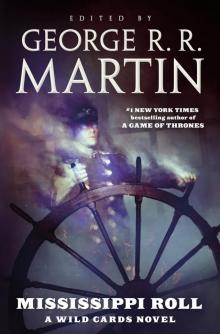 Mississippi Roll
Mississippi Roll Wild Cards V: Down and Dirty
Wild Cards V: Down and Dirty Busted Flush
Busted Flush When the Devil Drives
When the Devil Drives Dying of the Light
Dying of the Light The Ice Dragon
The Ice Dragon Sandkings
Sandkings Jokertown Shuffle
Jokertown Shuffle Dreamsongs. Volume II
Dreamsongs. Volume II Deuces Down
Deuces Down When We Were Heroes
When We Were Heroes Warriors
Warriors In the House of the Worm
In the House of the Worm Death Draws Five
Death Draws Five Dreamsongs. Volume I
Dreamsongs. Volume I Marked Cards
Marked Cards Dreamsongs
Dreamsongs Card Sharks
Card Sharks Dangerous Women
Dangerous Women Inside Straight
Inside Straight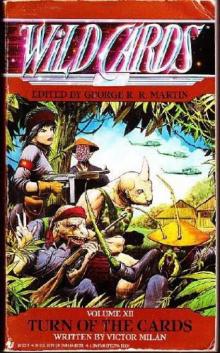 Turn of the Cards
Turn of the Cards Fevre Dream
Fevre Dream High Stakes: A Wild Cards Novel
High Stakes: A Wild Cards Novel Windhaven
Windhaven Tuf Voyaging
Tuf Voyaging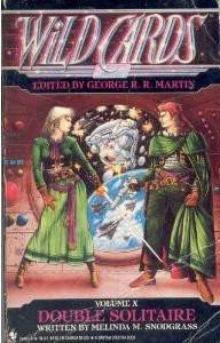 Double Solitaire
Double Solitaire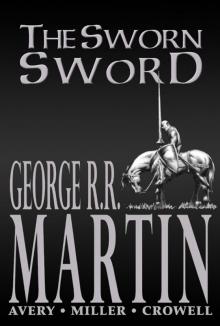 The Sworn Sword
The Sworn Sword Low Chicago
Low Chicago Dead Man's Hand
Dead Man's Hand Wild Cards
Wild Cards Black Trump
Black Trump One Eyed Jacks
One Eyed Jacks Wild Cards: Aces Abroad
Wild Cards: Aces Abroad Lowball: A Wild Cards Novel
Lowball: A Wild Cards Novel Double Solitaire (2019 Edition)
Double Solitaire (2019 Edition) Dealer's Choice
Dealer's Choice Ace in the Hole
Ace in the Hole A Song for Lya: And Other Stories
A Song for Lya: And Other Stories Three Kings
Three Kings Knaves Over Queens
Knaves Over Queens Joker Moon
Joker Moon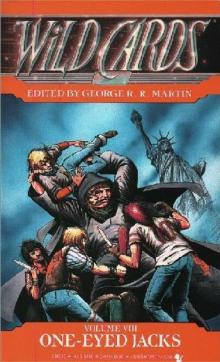 One Eyed Jacks wc-8
One Eyed Jacks wc-8 Down And Dirty wc-5
Down And Dirty wc-5 Mississippi Roll_A Wild Cards Novel
Mississippi Roll_A Wild Cards Novel A Feast for Dragons
A Feast for Dragons The Sworn Sword ttodae-2
The Sworn Sword ttodae-2 Aces High wc-2
Aces High wc-2 Wild Cards 13 : Card Sharks
Wild Cards 13 : Card Sharks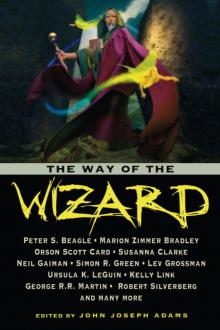 Way of the Wizard
Way of the Wizard Wild Cards VIII: One-Eyed Jacks
Wild Cards VIII: One-Eyed Jacks A Dance With Dragons: Book 5 of A Song of Ice and Fire (Song of Ice & Fire 5)
A Dance With Dragons: Book 5 of A Song of Ice and Fire (Song of Ice & Fire 5) The Princess and The Queen, Or, The Blacks and The Greens (a song of ice and fire)
The Princess and The Queen, Or, The Blacks and The Greens (a song of ice and fire) Wild Cards VI--Ace in the Hole
Wild Cards VI--Ace in the Hole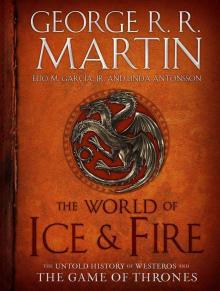 The World of Ice & Fire: The Untold History of Westeros and the Game of Thrones (A Song of Ice and Fire)
The World of Ice & Fire: The Untold History of Westeros and the Game of Thrones (A Song of Ice and Fire) The World of Ice & Fire: The Untold History of Westeros and the Game of Thrones
The World of Ice & Fire: The Untold History of Westeros and the Game of Thrones Busted Flush wc-19
Busted Flush wc-19 A Knight of the Seven Kingdoms
A Knight of the Seven Kingdoms Nightflyers: The Illustrated Edition
Nightflyers: The Illustrated Edition Wild Cards IV
Wild Cards IV Portraits of His Children
Portraits of His Children Dead Mans Hand wc-7
Dead Mans Hand wc-7 Jokers Wild wc-3
Jokers Wild wc-3 The Lonely Songs of Laren Dorr
The Lonely Songs of Laren Dorr Wild Cards III: Jokers Wild
Wild Cards III: Jokers Wild A Game of Thrones Enhanced Edition
A Game of Thrones Enhanced Edition Nightflyers & Other Stories
Nightflyers & Other Stories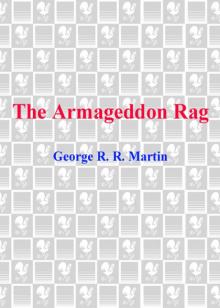 Armageddon Rag
Armageddon Rag Wild Cards: Inside Straight
Wild Cards: Inside Straight A Song for Lya
A Song for Lya A Dance with Dragons: A Song of Ice and Fire: Book Five
A Dance with Dragons: A Song of Ice and Fire: Book Five Song of Fire & Ice 01 - A Game of Thrones
Song of Fire & Ice 01 - A Game of Thrones Death Draws Five wc-17
Death Draws Five wc-17 Turn of the Cards w-12
Turn of the Cards w-12 Wild Cards 14 - Marked Cards
Wild Cards 14 - Marked Cards Hunter's Run
Hunter's Run The Glass Flower
The Glass Flower A Clash of Kings asoiaf-2
A Clash of Kings asoiaf-2 A Game of Thrones 5-Book Bundle: A Song of Ice and Fire Series: A Game of Thrones, A Clash of Kings, A Storm of Swords, A Feast for Crows, and A Dance with Dragons (Song of Ice & Fire)
A Game of Thrones 5-Book Bundle: A Song of Ice and Fire Series: A Game of Thrones, A Clash of Kings, A Storm of Swords, A Feast for Crows, and A Dance with Dragons (Song of Ice & Fire) Ace In The Hole wc-6
Ace In The Hole wc-6 Suicide Kings wc-20
Suicide Kings wc-20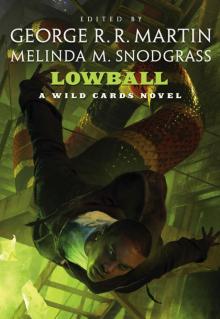 Lowball
Lowball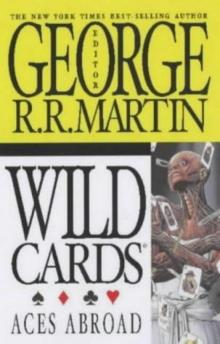 Aces Abroad wc-4
Aces Abroad wc-4 George R. R. Martin's a Game of Thrones 4-Book Bundle
George R. R. Martin's a Game of Thrones 4-Book Bundle A Feast for Crows asoiaf-4
A Feast for Crows asoiaf-4 A Game of Thrones asoiaf-1
A Game of Thrones asoiaf-1 The Mystery Knight ttodae-3
The Mystery Knight ttodae-3 Double Solitaire w-10
Double Solitaire w-10 Wild Cards 15 - Black Trump
Wild Cards 15 - Black Trump A Storm of Swords asoiaf-3
A Storm of Swords asoiaf-3 The Hedge Knight ttodae-1
The Hedge Knight ttodae-1 Dreamsongs 2-Book Bundle
Dreamsongs 2-Book Bundle The World of Ice & Fire
The World of Ice & Fire Starlady & Fast-Friend
Starlady & Fast-Friend Old Mars
Old Mars Fantasy For Good: A Charitable Anthology
Fantasy For Good: A Charitable Anthology Wild Cards V
Wild Cards V A Dance with Dragons asoiaf-5
A Dance with Dragons asoiaf-5 Dealer's Choice w-11
Dealer's Choice w-11 The Book of Magic
The Book of Magic A Game of Thrones 4-Book Bundle
A Game of Thrones 4-Book Bundle Texas Hold 'Em
Texas Hold 'Em Wildcards wc-1
Wildcards wc-1 Rogues
Rogues Old Venus
Old Venus